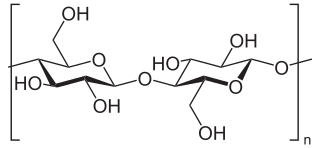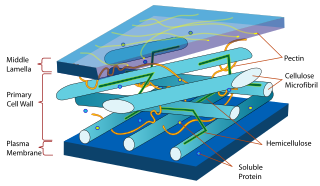Related Research Articles

A cell wall is a structural layer that surrounds some cell types, found immediately outside the cell membrane. It can be tough, flexible, and sometimes rigid. Primarily, it provides the cell with structural support, shape, protection, and functions as a selective barrier. Another vital role of the cell wall is to help the cell withstand osmotic pressure and mechanical stress. While absent in many eukaryotes, including animals, cell walls are prevalent in other organisms such as fungi, algae and plants, and are commonly found in most prokaryotes, with the exception of mollicute bacteria.

Cellulose is an organic compound with the formula (C
6H
10O
5)
n, a polysaccharide consisting of a linear chain of several hundred to many thousands of β(1→4) linked D-glucose units. Cellulose is an important structural component of the primary cell wall of green plants, many forms of algae and the oomycetes. Some species of bacteria secrete it to form biofilms. Cellulose is the most abundant organic polymer on Earth. The cellulose content of cotton fibre is 90%, that of wood is 40–50%, and that of dried hemp is approximately 57%.

A hemicellulose is one of a number of heteropolymers, such as arabinoxylans, present along with cellulose in almost all terrestrial plant cell walls. Cellulose is crystalline, strong, and resistant to hydrolysis. Hemicelluloses are branched, shorter in length than cellulose, and also show a propensity to crystallize. They can be hydrolyzed by dilute acid or base as well as a myriad of hemicellulase enzymes.

Polysaccharides, or polycarbohydrates, are the most abundant carbohydrates found in food. They are long-chain polymeric carbohydrates composed of monosaccharide units bound together by glycosidic linkages. This carbohydrate can react with water (hydrolysis) using amylase enzymes as catalyst, which produces constituent sugars. They range in structure from linear to highly branched. Examples include storage polysaccharides such as starch, glycogen and galactogen and structural polysaccharides such as hemicellulose and chitin.

Xylose is a sugar first isolated from wood, and named for it. Xylose is classified as a monosaccharide of the aldopentose type, which means that it contains five carbon atoms and includes an aldehyde functional group. It is derived from hemicellulose, one of the main constituents of biomass. Like most sugars, it can adopt several structures depending on conditions. With its free aldehyde group, it is a reducing sugar.

Xylan is a type of hemicellulose, a polysaccharide consisting mainly of xylose residues. It is found in plants, in the secondary cell walls of dicots and all cell walls of grasses. Xylan is the third most abundant polysaccharide on Earth, after cellulose and chitin.

Lignocellulose refers to plant dry matter (biomass), so called lignocellulosic biomass. It is the most abundantly available raw material on the Earth for the production of biofuels. It is composed of two kinds of carbohydrate polymers, cellulose and hemicellulose, and an aromatic-rich polymer called lignin. Any biomass rich in cellulose, hemicelluloses, and lignin are commonly referred to as lignocellulosic biomass. Each component has a distinct chemical behavior. Being a composite of three very different components makes the processing of lignocellulose challenging. The evolved resistance to degradation or even separation is referred to as recalcitrance. Overcoming this recalcitrance to produce useful, high value products requires a combination of heat, chemicals, enzymes, and microorganisms. These carbohydrate-containing polymers contain different sugar monomers and they are covalently bound to lignin.

In biochemistry, glycoside hydrolases are a class of enzymes which catalyze the hydrolysis of glycosidic bonds in complex sugars. They are extremely common enzymes, with roles in nature including degradation of biomass such as cellulose (cellulase), hemicellulose, and starch (amylase), in anti-bacterial defense strategies, in pathogenesis mechanisms and in normal cellular function. Together with glycosyltransferases, glycosidases form the major catalytic machinery for the synthesis and breakage of glycosidic bonds.

Brassinolide is a plant hormone. The first isolated brassinosteroid, it was discovered when it was shown that pollen from rapeseed could promote stem elongation and cell division. The biologically active component was isolated and named brassinolide.
Expansins are a family of closely related nonenzymatic proteins found in the plant cell wall, with important roles in plant cell growth, fruit softening, abscission, emergence of root hairs, pollen tube invasion of the stigma and style, meristem function, and other developmental processes where cell wall loosening occurs. Expansins were originally discovered as mediators of acid growth, which refers to the widespread characteristic of growing plant cell walls to expand faster at low (acidic) pH than at neutral pH. Expansins are thus linked to auxin action. They are also linked to cell enlargement and cell wall changes induced by other plant hormones such as gibberellin, cytokinin, ethylene and brassinosteroids.
The secondary cell wall is a structure found in many plant cells, located between the primary cell wall and the plasma membrane. The cell starts producing the secondary cell wall after the primary cell wall is complete and the cell has stopped expanding. It is most prevalent in the Ground tissue found in vascular plants, with Collenchyma having little to no lignin, and Sclerenchyma having lignified secondary cells walls.
The plant cell wall is made up of hydrated polymetric material, allowing it to have viscoelastic properties. The primary cell wall of a plant consists of cellulose fibers, hemicellulose, and xyloglucans. This load bearing network is also surrounded by pectins and glycoproteins.

The UDP-forming form of cellulose synthase is the main enzyme that produces cellulose. Systematically, it is known as UDP-glucose:(1→4)-β-D-glucan 4-β-D-glucosyltransferase in enzymology. It catalyzes the chemical reaction:

Rhamnogalacturonan-II (RG-II) is a complex polysaccharide component of pectin that is found in the primary cell walls of dicotyledonous and monocotyledonous plants and gymnosperms. It is supposed to be crucial for the plant cell wall integrity. RG-II is also likely to be present in the walls of some lower plants. Its global structure is conserved across vascular plants, albeit a number of variations within the RGII side chains have been observed between different plants. RG-II is composed of 12 different glycosyl residues including D-rhamnose, D-apiose, D-galactose, L-galactose, Kdo, D-galacturonic acid, L-arabinose, D-xylose, and L-aceric acid, linked together by at least 21 distinct glycosidic linkages. Some resides are further modified via methylation and acetylation. It moreover supports borate mediated cross-linking between different RGII side-chain apiosyl residues. The backbone consists of a linear polymer of alpha-1,4-linked D-galactopyranosiduronic acid. RG-II can be isolated from different sources, such as apple juice and red wine.
Mixed-linkage glucan : xyloglucan endotransglucosylase (MXE) is a plant cell wall-modifying enzyme found in plants of the genus Equisetum. The enzyme is proposed, in vivo, to catalyse the endotransglucosylation of two different hemicellulose polysaccharides, mixed-linkage glucan and xyloglucan, by effectively 'stitching' them together. However only the 'stitching' of a mixed-linkage glucan polysaccharide to a xyloglucan oligosaccharide has actually been witnessed to date.
Mixed-linkage glucan (MLG), sometimes incorrectly referred to as beta-glucan, is a hemicellulosic polysaccharide consisting of β-D(1-3) and β-D(1-4) linked glucosyl residues. MLG is highly prevalent within the Poales, where it has important properties in the diet. In addition, although thought to be confined to the Poales, MLG has been found to be highly prevalent in plants of the distantly related genus Equisetum.
Xyloglucan endotransglucosylase (XET) is an apoplastic enzyme found across the plant kingdom. The enzyme catalyzes the endotransglucosylation of two xyloglucan polysaccharides, effectively 'stitching' them together.
Fibrolytic bacteria constitute a group of microorganisms that are able to process complex plant polysaccharides thanks to their capacity to synthesize cellulolytic and hemicellulolytic enzymes. Polysaccharides are present in plant cellular cell walls in a compact fiber form where they are mainly composed of cellulose and hemicellulose.
Glucuronoxylans are the primary components of hemicellulose as found in hardwood trees, for example birch. They are hemicellulosic plant cell wall polysaccharides, containing glucuronic acid and xylose as its main constituents. They are linear polymers of β-D-xylopyranosyl units linked by (1→4) glycosidic bonds, with many of the xylose units substituted with 2, 3 or 2,3-linked glucuronate residue, which are often methylated at position 4. Most of the glucuronoxylans have single 4-O-methyl-α-D-glucopyranosyl uronate residues (MeGlcA) attached at position 2. This structural type is usually named as 4-O-methyl-D-glucurono-D-xylan (MGX).

In molecular biology, the xyloglucan endo-transglycosylase (XET) is an enzyme that is involved in the metabolism of xyloglucan, which is a component of plant cell walls. This enzyme is part of glycoside hydrolase family 16.
References
- ↑ LEV Del Bem and M Vincentz (2010) Evolution of xyloglucan-related genes. BMC Evolutionary Biology, 10:340, 1-17
- ↑ Del-Bem LE (2018). "Xyloglucan evolution and the terrestrialization of green plants". New Phytologist. 219 (4): 1150–1153. doi: 10.1111/nph.15191 . hdl: 1843/36860 . PMID 29851097.
- ↑ Fry, Stephen C. (1989). "The Structure and Functions of Xyloglucan". Journal of Experimental Botany. 40 (1): 1–11. doi:10.1093/jxb/40.1.1.
- ↑ Moore PJ; Staehelin LA (1988). "Immunogold localisation of the cell wall matrix polysaccharides rhamnogalacturonan-I and xyloglucan during cell expansion and cytokinesis in Trifolium pratense L. - Implications for sectretory pathways". Planta. 174 (4): 433–445. doi:10.1007/BF00634471. PMID 24221558. S2CID 19272644.
- ↑ Larsbrink, Johan; Rogers, Theresa E.; Hemsworth, Glyn R.; McKee, Lauren S.; Tauzin, Alexandra S.; Spadiut, Oliver; Klinter, Stefan; Pudlo, Nicholas A.; Urs, Karthik; Koropatkin, Nicole M.; Creagh, A. Louise; Haynes, Charles A.; Kelly, Amelia G.; Cederholm, Stefan Nilsson; Davies, Gideon J.; Martens, Eric C.; Brumer, Harry (2014). "A discrete genetic locus confers xyloglucan metabolism in select human gut Bacteroidetes". Nature. 506 (7489): 498–502. Bibcode:2014Natur.506..498L. doi:10.1038/nature12907. PMC 4282169 . PMID 24463512.